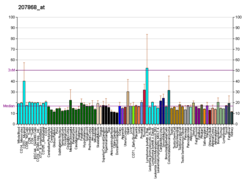CHRNA2
Appearance
Neuronal acetylcholine receptor subunit alpha-2, also known as nAChRα2, is a protein that in humans is encoded by the CHRNA2 gene.[5][6] The protein encoded by this gene is a subunit of certain nicotinic acetylcholine receptors (nAchR).
Function
Knockout of this gene in mice potentiates nicotine-modulated behaviors.[7] Using two different genetically modified mutant mouse lines (Chrna2L9'S/L9'S and Chrna2KO), findings highlight that α2* nAChRs influence hippocampus-dependent learning and memory and CA1 synaptic plasticity in adolescent mice. [8]
See also
References
- ^ a b c GRCh38: Ensembl release 89: ENSG00000120903 – Ensembl, May 2017
- ^ a b c GRCm38: Ensembl release 89: ENSMUSG00000022041 – Ensembl, May 2017
- ^ "Human PubMed Reference:". National Center for Biotechnology Information, U.S. National Library of Medicine.
- ^ "Mouse PubMed Reference:". National Center for Biotechnology Information, U.S. National Library of Medicine.
- ^ Anand R, Lindstrom J (Sep 1992). "Chromosomal localization of seven neuronal nicotinic acetylcholine receptor subunit genes in humans". Genomics. 13 (4): 962–7. doi:10.1016/0888-7543(92)90008-G. PMID 1505988.
- ^ "Entrez Gene: CHRNA2 cholinergic receptor, nicotinic, alpha 2 (neuronal)".
- ^ Lotfipour S, Byun JS, Leach P, Fowler CD, Murphy NP, Kenny PJ, Gould TJ, Boulter J (May 2013). "Targeted Deletion of the Mouse α2 Nicotinic Acetylcholine Receptor Subunit Gene (Chrna2) Potentiates Nicotine-Modulated Behaviors". J. Neurosci. 33 (18): 7728–41. doi:10.1523/JNEUROSCI.4731-12.2013. PMC 3831006. PMID 23637165.
- ^ Lotfipour S, Mojica C, Nakauchi S, Lipovsek M, Silverstein S, Cushman J, Tirtorahardjo J, Poulos A, Elgoyhen AB, Sumikawa K, Fanselow MS, Boulter J (May 2017). "α2* Nicotinic acetylcholine receptors influence hippocampus-dependent learning and memory in adolescent mice". Learn Mem. 24 (6): 231–244. doi:10.1101/lm.045369.117. PMC 5435881. PMID 28507032.
Further reading
- Hogg RC, Raggenbass M, Bertrand D (2003). "Nicotinic acetylcholine receptors: from structure to brain function". Rev. Physiol. Biochem. Pharmacol. Reviews of Physiology, Biochemistry and Pharmacology. 147: 1–46. doi:10.1007/s10254-003-0005-1. ISBN 978-3-540-01365-5. PMID 12783266.
- Wood S, Schertzer M, Yaremko ML (1995). "Identification of the human neuronal nicotinic cholinergic alpha 2 receptor locus, (CHRNA2), within an 8p21 mapped locus, by sequence homology with rat DNA". Somat. Cell Mol. Genet. 21 (2): 147–50. doi:10.1007/BF02255790. PMID 7570187.
- García-Colunga J, Miledi R (1995). "Effects of serotonergic agents on neuronal nicotinic acetylcholine receptors". Proc. Natl. Acad. Sci. U.S.A. 92 (7): 2919–23. doi:10.1073/pnas.92.7.2919. PMC 42330. PMID 7708749.
- Elliott KJ, Ellis SB, Berckhan KJ, et al. (1997). "Comparative structure of human neuronal alpha 2-alpha 7 and beta 2-beta 4 nicotinic acetylcholine receptor subunits and functional expression of the alpha 2, alpha 3, alpha 4, alpha 7, beta 2, and beta 4 subunits". J. Mol. Neurosci. 7 (3): 217–28. doi:10.1007/BF02736842. PMID 8906617.
- Chavez-Noriega LE, Crona JH, Washburn MS, et al. (1997). "Pharmacological characterization of recombinant human neuronal nicotinic acetylcholine receptors h alpha 2 beta 2, h alpha 2 beta 4, h alpha 3 beta 2, h alpha 3 beta 4, h alpha 4 beta 2, h alpha 4 beta 4 and h alpha 7 expressed in Xenopus oocytes". J. Pharmacol. Exp. Ther. 280 (1): 346–56. PMID 8996215.
- Navaneetham D, Penn A, Howard J, Conti-Fine BM (1997). "Expression of the alpha 7 subunit of the nicotinic acetylcholine receptor in normal and myasthenic human thymuses". Cell. Mol. Biol. (Noisy-le-grand). 43 (3): 433–42. PMID 9193799.
- Sato KZ, Fujii T, Watanabe Y, et al. (1999). "Diversity of mRNA expression for muscarinic acetylcholine receptor subtypes and neuronal nicotinic acetylcholine receptor subunits in human mononuclear leukocytes and leukemic cell lines". Neurosci. Lett. 266 (1): 17–20. doi:10.1016/S0304-3940(99)00259-1. PMID 10336173.
- Bertrand D, Picard F, Le Hellard S, et al. (2002). "How mutations in the nAChRs can cause ADNFLE epilepsy". Epilepsia. 43 Suppl 5: 112–22. doi:10.1046/j.1528-1157.43.s.5.16.x. PMID 12121305.
- Jin P, Fu GK, Wilson AD, et al. (2004). "PCR isolation and cloning of novel splice variant mRNAs from known drug target genes". Genomics. 83 (4): 566–71. doi:10.1016/j.ygeno.2003.09.023. PMID 15028279.
- Kimura K, Wakamatsu A, Suzuki Y, et al. (2006). "Diversification of transcriptional modulation: Large-scale identification and characterization of putative alternative promoters of human genes". Genome Res. 16 (1): 55–65. doi:10.1101/gr.4039406. PMC 1356129. PMID 16344560.
- Nusbaum C, Mikkelsen TS, Zody MC, et al. (2006). "DNA sequence and analysis of human chromosome 8". Nature. 439 (7074): 331–5. doi:10.1038/nature04406. PMID 16421571.
- Aridon P, Marini C, Di Resta C, et al. (2006). "Increased Sensitivity of the Neuronal Nicotinic Receptor α2 Subunit Causes Familial Epilepsy with Nocturnal Wandering and Ictal Fear". Am. J. Hum. Genet. 79 (2): 342–50. doi:10.1086/506459. PMC 1559502. PMID 16826524.
External links
- CHRNA2+protein,+human at the U.S. National Library of Medicine Medical Subject Headings (MeSH)
- Human CHRNA2 genome location and CHRNA2 gene details page in the UCSC Genome Browser.
This article incorporates text from the United States National Library of Medicine, which is in the public domain.





